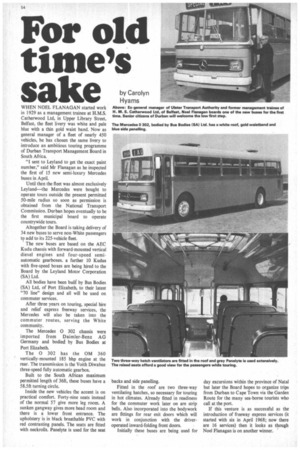For old times sa
Page 56

If you've noticed an error in this article please click here to report it so we can fix it.
by Carolyn Hyams
WHEN NOEL FLANAGAN started work in 1929 as a management trainee at H.M.S. Catherwood Ltd, in Upper Library Street, Belfast, the fleet livery was white and pale blue with a thin gold waist band. Now as general manager of a fleet of nearly 450 vehicles, he has chosen the same livery to introduce an ambitious touring programme of Durban Transport Management Board in South Africa.
"I sent to Leyland to get the exact paint number," said Mr Flanagan as he inspected the first of 15 new semi-luxury Mercedes buses in April.
Until then the fleet was almost exclusively Leyland—the Mercedes were bought to operate tours outside the present permitted 50-mile radius so soon as permission is obtained from the National Transport Commission. Durban hopes eventually to be the first municipal board to operate countrywide tours.
Altogether the Board is taking delivery of 34 new buses to serve non-White passengers t? add to its 225-vehicle fleet. The new buses are based on the AEC Kudu chassis with forward-mounted vertical diesel engines and four-speed semiautomatic gearboxes. a further 10 Kudus with five-speed boxes are being hired to the Board by the Leyland Motor Corporation (SA) Ltd.
All bodies have been buili by Bus Bodies (SA) Ltd, of Port Elizabeth, to their latest "70 line" design and all will be used on commuter services.
After three years on touring, special hire and relief express freeway services, the Mercedes will also be taken into the commuter routes, serving the White community.
The Mercedes 0 302 chassis were imported from Daimler-Benz AG Germany and bodied by Bus Bodies at Port Elizabeth.
The 0 302 has the OM 360 vertically-mounted 185 bhp engine at the rear. The transmission is the Voith Diwabus three-speed fully automatic gearbox.
Built to the South African maximum permitted length of 36ft, these buses have a 58.5 ft turning circle.
Inside the new vehicles the accent is on practical comfort. Forty-nine seats instead of the normal 57 give more leg room. A sunken gangway gives more head room and there is a lower front entrance. The upholstery is in black breathable PVC with red contrasting panels. The seats are fitted with neckrolls. Panelyte is used for the seat backs and side panelling.
Fitted in the roof are two three-way ventilating hatches, so necessary for touring in hot climates. Already fitted in readiness for the commuter work later on are strip bells. Also incorporated into the bodywork are fittings for rear exit doors which will work in conjunction with the driveroperated inward-folding front doors.
Initially these buses are being used for day excursions within the province of Natal but later the Board hopes to organize trips from Durban to Cape Town via the Garden Route for the many sea-borne tourists who call at the port.
If this venture is as successful as the introduction of freeway express services (it started with six in April 1968; now there are 16 services) then it looks as though Noel Flanagan is on another winner. I
























































































































